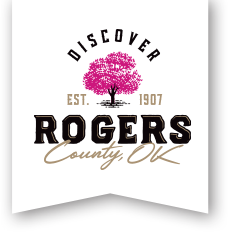Will Rogers Birthplace Ranch
Experience a unique glimpse into the life of world-famous vaudeville performer, actor, Cherokee cowboy and American humorist Will Rogers (1879-1935) at the Will Rogers Birthplace Ranch, which features Rogers’s original home and a 162-acre working ranch where visitors can enjoy lovely views of Oologah Lake and have a picnic with friends and family.
The log-walled, two-story home where Rogers was born was built in 1875 within the Cooweescoowee district of Cherokee Nation. It was designed in the Greek Revival architectural style that was popular throughout the South at this time. In fact, a house almost identical to Rogers’s boyhood home can be found on the outskirts of Guntersville, Alabama. The Oologah home, nicknamed “The White House on the Verdigris,” is a rare surviving example of buildings on the former Indian Territory frontier.
Rogers’s mother and father were Cherokees, and Rogers was proud of his heritage. During vaudeville performances, Will often joked, “My ancestors didn’t come over from the Mayflower, but they met the boat.” His mother, Mary America Rogers, was born into the Paint clan. His father, Clement Vann Rogers, was a Cherokee statesman and judge who would later help draft the constitution for the state of Oklahoma.
Will Rogers grew up on his father’s ranch, which at its height was nearly 60,000 acres. There, he learned his love of cowboying from the ranch hands, including roping from Cherokee freedman Dan Walker. He rode the range and joined the long, dusty cattle drives from Texas to the Kansas railheads. His physical prowess in precisely and expertly flipping heavy rope coils demonstrated his training, fitness, and strength. Using that same deft touch with a lasso, Rogers created a top vaudeville and cinema persona, “The Cherokee Kid.” From 1899 to 1902, after his father had moved into Claremore, Will Rogers operated the ranch himself, renaming it the Dog Iron Ranch after his cattle brand.
Today, the Will Rogers Birthplace Ranch features a historically accurate barn with a climate-controlled classroom and a historical video program. The working ranch is home to Texas Longhorn cattle and other livestock.


